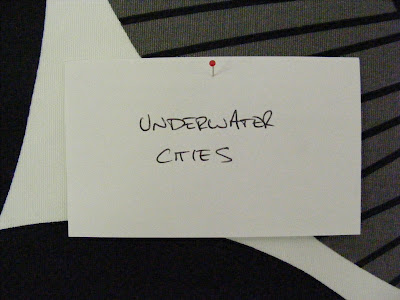Where do you get those ideas?
>> Tuesday, July 14, 2009

But once you get an idea, how do you develop it? That's something perhaps we can quantify, even teach. Wendi ran across an excellent post by an illustrator named Nate Williams, who talks about how he cultivates ideas for the editorial illustration assignments he gets. It's really simple, and it's really effective. Once he gets an assignment, he breaks the job down into two or three key concepts. An assignment to illustrate "Empowering Teachers with Technology," for example, gave him his three key words ready made. Then he took each of those words--empowering, teachers, and technology--and he created a quick chart, with each word as the head of a column. Underneath each, he then brainstormed words and images he associated with that key word. "Teacher," for example, conjured up images of teachers, desks, books, brains, chalk boards, world maps, apples, class rooms, graduation caps, and diplomas.
Once Nate has images and ideas in each column, he starts to free associate items from all the columns to see what he gets. Here are a few examples from his chart:
- A crane driven by a teacher lowering a light-bulb into a student’s head.
- A student climbing a DNA ladder to draw a light-bulb on a chalkboard
- Students and a teacher crossing a bridge of computers to the moon
I did something similar to this on the new pitch I'm working up. For some time, I've been trying to find a way to combine Lovecraft's world of Cthulhu with a steampunk universe in a middle grade setting. (If neither of those words make any sense to you, I've added links to Wikipedia.) I almost had too much information to digest--a glut of ideas and concepts, but no way to focus them into a great middle grade story.
After struggling with this for a while, I turned to my new design board. I got back to basics. WHen I was a kid, I wanted any book I read to be full of awesome, and that's what I want to write. Any middle grade pitch I made had to be full of awesome, so I started with that, on a card, as a visual reminder. Nothing would go on the board if it was not full of awesome.
 Using the reminder to be "full of awesome" as my center piece, I began to surround it with concepts and images that were, well, full of awesome.
Using the reminder to be "full of awesome" as my center piece, I began to surround it with concepts and images that were, well, full of awesome.






 And there are more. Lots more. And I keep expanding the idea cloud every time something occurs to me. It's not finite.
And there are more. Lots more. And I keep expanding the idea cloud every time something occurs to me. It's not finite. I knew I wouldn't be able to put all these ideas in a single book, but these were elements of the awesome world I wanted to build. Some would be window dressing--fezs and brass goggles--while others would become characters--machine men and mad scientists--and others would be significant story elements--tentacled monsters and underwater cities, for example. Once I had enough awesome elements on the design board, I was able to sit back and stare at the concepts, putting them together in different ways until a story--made of awesome--began to form.
I knew I wouldn't be able to put all these ideas in a single book, but these were elements of the awesome world I wanted to build. Some would be window dressing--fezs and brass goggles--while others would become characters--machine men and mad scientists--and others would be significant story elements--tentacled monsters and underwater cities, for example. Once I had enough awesome elements on the design board, I was able to sit back and stare at the concepts, putting them together in different ways until a story--made of awesome--began to form. Every step of the way, I stopped and asked myself--is what I'm outlining awesome? Am I getting away from cool things? Has the pace of the awesome slowed down? I'm still working on that. It's difficult to keep up something like that, but it's definitely rewarding when it happens. I think Rick Riodan's The Lightning Thief is a pretty good example of "full of awesome." There are very few moments in that book where something awesome isn't happening--and those moments are merely brief preludes to getting to the awesome. The same could be said of the Harry Potter novels, and many other successful children's books. Unlike most other genres, there is nothing grauitous about packing a children's book full of awesome. In fact, I would argue it's a requirement.
Every step of the way, I stopped and asked myself--is what I'm outlining awesome? Am I getting away from cool things? Has the pace of the awesome slowed down? I'm still working on that. It's difficult to keep up something like that, but it's definitely rewarding when it happens. I think Rick Riodan's The Lightning Thief is a pretty good example of "full of awesome." There are very few moments in that book where something awesome isn't happening--and those moments are merely brief preludes to getting to the awesome. The same could be said of the Harry Potter novels, and many other successful children's books. Unlike most other genres, there is nothing grauitous about packing a children's book full of awesome. In fact, I would argue it's a requirement.








2 comments:
This is a fabulous post. It's one of the more enlightening takes on the writing process I've read.
Full of awesome!
Post a Comment